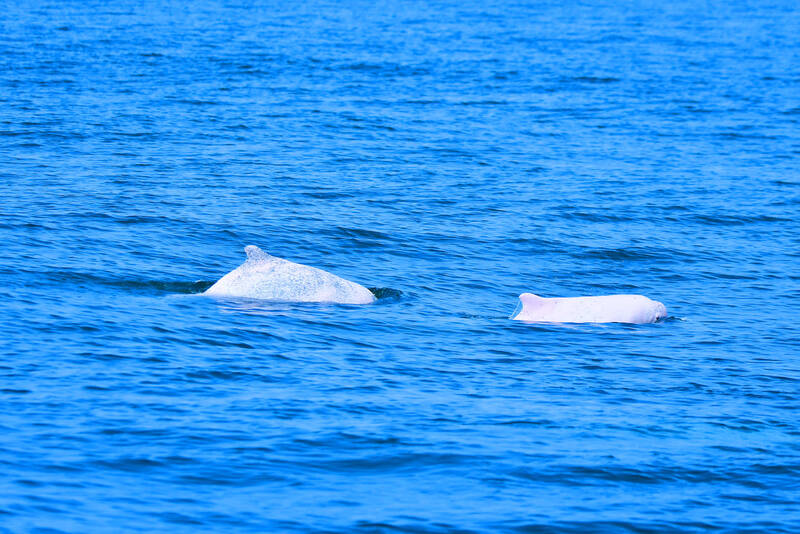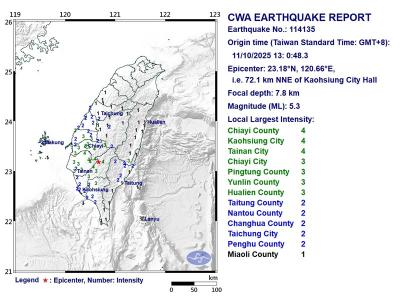Taiwanese white dolphins might become functionally extinct in the next five years if no effort is made to protect the critically endangered species, an academic said yesterday, calling for the termination of inshore gillnet fishing and illegal trawling.
The dolphins prefer to live around river estuaries and their distribution is highly restricted to shallow coastal waters west of Taiwan, Canadian researcher John Wang (王愈超) said yesterday.
Wang was the first to document the scientific sighting of Taiwanese white dolphins in waters southeast of Taiwan in 2002.

Photo courtesy of environmental groups
The population size was already alarmingly small in 2002, when there were estimated to be no more than 100 dolphins along the western coast of Taiwan, he said.
However, the number has declined to a new low of 45 to 50 this summer, Wang said, adding that it takes Taiwanese white dolphins five years to produce a calf if it survives.
The species has been listed by the International Union for Conservation of Nature Red List as “critically endangered” and is declining at a rate of 3 percent to 4 percent per year, he said.
That means the death rate is higher than the birthrate and the extinction vortex is imminent, Wang said.
Taiwanese white dolphins are susceptible to noise and chemical pollution in the air and water, so coastal development projects, such as the construction of wind turbine plants or liquefied natural gas receiving terminals, are threats, and reduce the dolphins’ food and habitat, he said.
Developers are building offshore wind turbines, given the government’s green energy policies, but they are also competing with the dolphins for shallow water sites, where development costs are lower, Wang said.
The port expansion project at Taichung Harbor — waters that 90 percent of dolphins pass through — could also undermine their habitat, with construction noises and increased vessel traffic forcing them to take detours and venture into potentially dangerous waters, he said.
Coastal development projects, such as the port expansion, are also killing the food of Taiwanese white dolphins, including the catfish, Wang added.
Gillnets used in coastal fisheries, as well as illegal inshore trawling, are also a major threat, as they could trap, injure or kill dolphins, he said, adding that the threat could be removed immediately by changing net fisheries’ practices.
Asked when Taiwanese white dolphins are projected to become extinct, Wang said that researchers are not sure about the exact timing, as the species’ reproductive biology remained to be fully explored.
Given that Taiwanese white dolphins can live for a long time, the species might lose the ability to reproduce while they are still alive and become functionally extinct, he said.
“I would say [their extinction] cannot be recovered in the next five years if no moves are taken to address problems like gillnets and environmental pollutions in Taiwan,” Wang said.

The Central Weather Administration (CWA) today issued a sea warning for Typhoon Fung-wong effective from 5:30pm, while local governments canceled school and work for tomorrow. A land warning is expected to be issued tomorrow morning before it is expected to make landfall on Wednesday, the agency said. Taoyuan, and well as Yilan, Hualien and Penghu counties canceled work and school for tomorrow, as well as mountainous district of Taipei and New Taipei City. For updated information on closures, please visit the Directorate-General of Personnel Administration Web site. As of 5pm today, Fung-wong was about 490km south-southwest of Oluanpi (鵝鑾鼻), Taiwan's southernmost point.

Almost a quarter of volunteer soldiers who signed up from 2021 to last year have sought early discharge, the Legislative Yuan’s Budget Center said in a report. The report said that 12,884 of 52,674 people who volunteered in the period had sought an early exit from the military, returning NT$895.96 million (US$28.86 million) to the government. In 2021, there was a 105.34 percent rise in the volunteer recruitment rate, but the number has steadily declined since then, missing recruitment targets, the Chinese-language United Daily News said, citing the report. In 2021, only 521 volunteers dropped out of the military, the report said, citing

A magnitude 5.3 earthquake struck Kaohsiung at 1pm today, the Central Weather Administration said. The epicenter was in Jiasian District (甲仙), 72.1km north-northeast of Kaohsiung City Hall, at a depth of 7.8km, agency data showed. There were no immediate reports of damage. The earthquake's intensity, which gauges the actual effects of a temblor, was highest in Kaohsiung and Tainan, where it measured a 4 on Taiwan's seven-tier intensity scale. It also measured a 3 in parts of Chiayi City, as well as Pingtung, Yunlin and Hualien counties, data showed.

Nearly 5 million people have signed up to receive the government’s NT$10,000 (US$322) universal cash handout since registration opened on Wednesday last week, with deposits expected to begin tomorrow, the Ministry of Finance said yesterday. After a staggered sign-up last week — based on the final digit of the applicant’s national ID or Alien Resident Certificate number — online registration is open to all eligible Taiwanese nationals, foreign permanent residents and spouses of Taiwanese nationals. Banks are expected to start issuing deposits from 6pm today, the ministry said. Those who completed registration by yesterday are expected to receive their NT$10,000 tomorrow, National Treasury